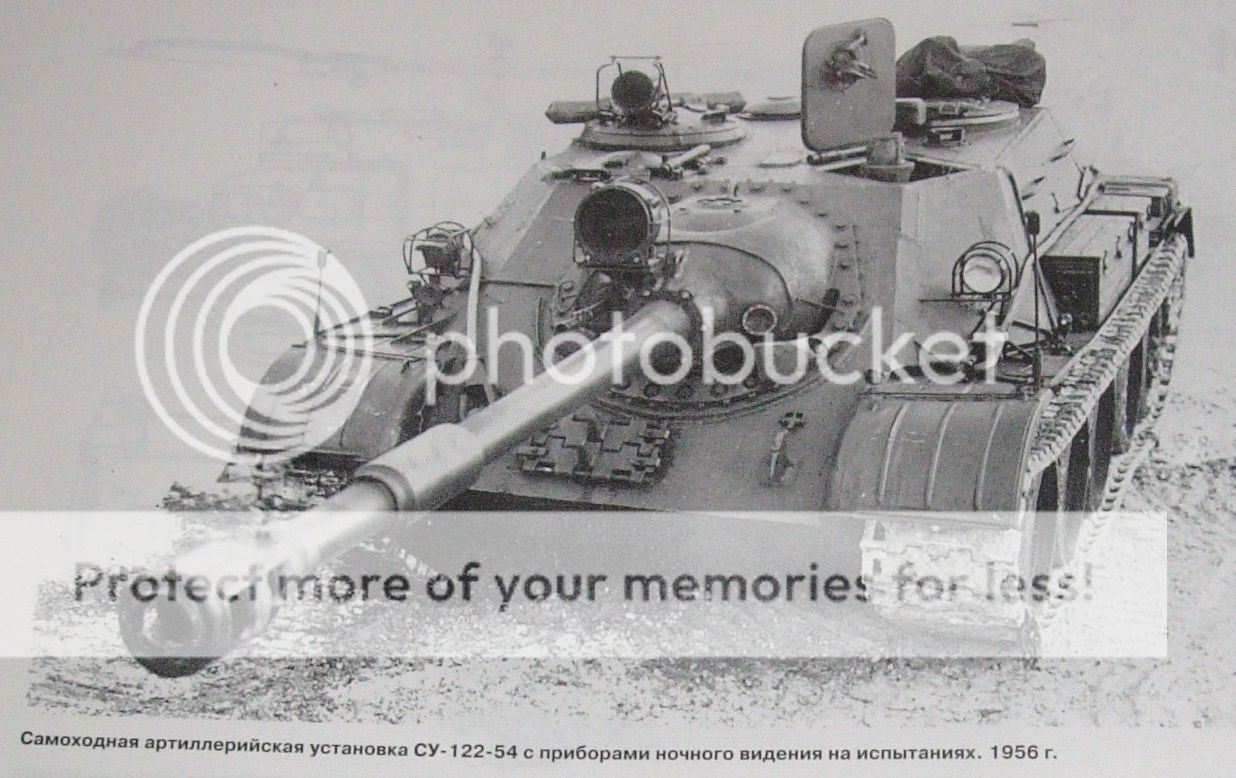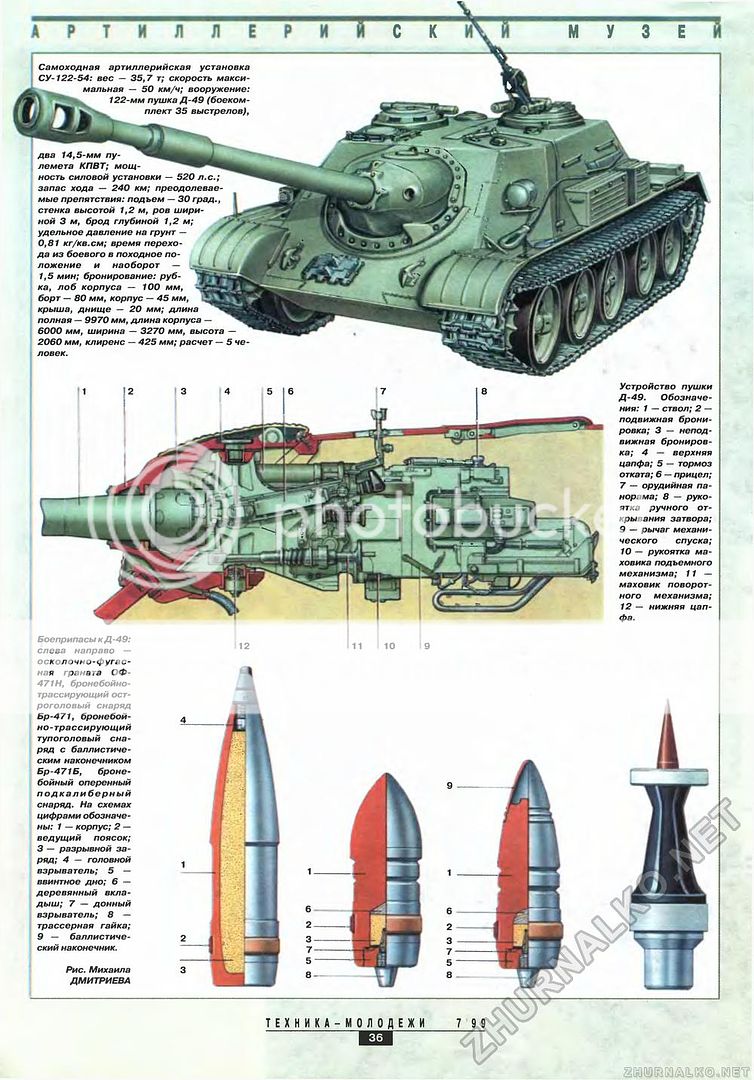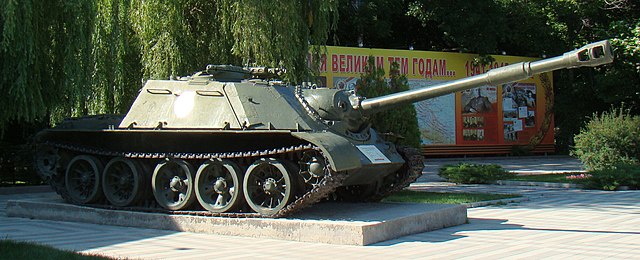 The confidential SU-122-54 Assault gun was also a tank destroyer built in limited numbers, from 1949 and circa 1955-56, based on the new T-54 chassis. The prototype was tested until greenlight for production, which lasted from 1955 to 1957. The armament was the powerful 122 mm D-49S gun, a development of the same caliber WW2 model, completed by two 14.5 mm heavy machine guns for self defence while in addition the commander was given a brand new optical rangefinder sighting system. Its chassis also served for a wide variety of support vehicle, after this tank hunter has been retired from service. Before that, it was made ready to encounter heavy British and US Tanks. A few also participated in the Prague Spring in August 1968 (Operation Danube), probably their only significant operational use.
The confidential SU-122-54 Assault gun was also a tank destroyer built in limited numbers, from 1949 and circa 1955-56, based on the new T-54 chassis. The prototype was tested until greenlight for production, which lasted from 1955 to 1957. The armament was the powerful 122 mm D-49S gun, a development of the same caliber WW2 model, completed by two 14.5 mm heavy machine guns for self defence while in addition the commander was given a brand new optical rangefinder sighting system. Its chassis also served for a wide variety of support vehicle, after this tank hunter has been retired from service. Before that, it was made ready to encounter heavy British and US Tanks. A few also participated in the Prague Spring in August 1968 (Operation Danube), probably their only significant operational use.
Development history

The Army wanted in 1948 a long range tank hunter based on the new chassis of the T-54. It was designated "Object 600" when in development and IT-122 at the end of it. In 1952, five prototypes tested the 122mm D-49 tank gun, developed at Plant No.9 in Sverdlovsk. Project manager for the new project was I.S.Bushnev. The leading designer was A.E.Sulin.
By decision of the Council of Ministers, the development of “Object 600” was due to just be made in a few weeks, but creating a working documentation took much longer than anticipated and was associated with problems with several suppliers. Plant No. 9 in Sverdlovsk manufactured the D-25 cannons but failed to send the armament documentation to Omsk. They arrived much later forcing OKB-174 to stop all work, resumed a few months off schedule. At the end of 1948, OKB-174 wrote the details of the project and and started work on design features. A wooden mockup was built to test design ideas and in December, documentation and layout were comleted. It was received by the special commission of the Ministry of Transport Engineering and the project was approved. However the design office ordered some improvements, to some shortcomings. Half a year were necessary to eliminate the identified deficiencies. In July 1949, a new model was built in Omsk, shown to the commission and by August it was officially approved.
From there, OKB-174 specialists prepared the documentation for the construction of a working prototype, soon soon suspended due to chassis issues. Serial production manwhile of the T-54 in parralel was so improved, changes were needed to be ported on the Chassis used by mid-1949 and Object 600 was entirely revised to accept these changes. Omsk OKB-174 sent documentation to Plant No. 183 in Nizhny Tagil (OKB-183) for pre-production of the prototype and by mid-October 1949, new technical specifications were issued, trigerring a change in main design features like the layout of the hull and delays accumulated.
By May 1950, Object 600 was returned to its original design bureau in Omsk and they rejected proposals from OKB-183 and continued their own development for a few months. Plant No. 174 started eventually construction of the finalized prototype, ready by December 1950. Factory tests started in 1951. OKB-174 designers refined the self-propelled gun to the point no change was made afterwards, but some adjustments later.

Alternative M62S tank gun
OKB at Plant No.172 (Perm) worked on a new tank gun developed for the T-10 serie as potential replacement for the 122 mm D-49, not only on the SU-122-54 when reaching production and the D-10T variant for the T-54. Both the heavy tank and the self-propelled gun were developed to carry the new gun under the designations M-62T and M-62S. Two prototypes of the first were completed in the autumn of 1954 but the M-62S took longer to develop, and was stopped on August 20, 1953 to be resumed later. Meanwhile, the 122mm M-62T tank gun was completed and tested from November 1953 and evolved into the M-62T2 which entered series production in 1957. It equipped the heavy tank T-10M and used of a multiple baffle muzzle brake. Work on the 122mm M-62S resumed in 1954, until the SU-122-54 prototype fitted with this new 122mm M-62S tank gun was demonstrated to the Chief Artillery Directorate in September 1955; This 122mm M-62S was not accepted for production and never entered service. Instead, for all its career, the SU-122-54 carried the M-62T, initial version of the T-10 heavy tank gun. However a single prototype of the M-62 armed SU-122A (Object 620) was produced.design of the 122/54
The SU-122/54 had a 6 m long hull, and overall with the protruding gun barrel, up to 9.97 meters. It was also 3.27 m wide and 2.07 m high. Only 77 vehicles were manufactured. They had minor differences between early and later versions, notably details about the commander’s cupola, casemate details, and roadwheels. The SU-122-54 did not used the regular T-54 chassis, but a modified one, with a large gap between the third and and fourth roadwheel, a bit like for the T-62. Its tailor-built superstructure was tailored around the 122 mm M-62-T gun but relatively cramped, so only 32 rounds could be carried. This main gun was given a fume extractor positioned behind the muzzle brake, unlike the early serie vehicles. The two KPVT heavy machine guns used for secondary armament, was separated between an anti-aircraft ring mount close to the commander’s hatch and the other was coaxial and can fire tracers for visual targeting. 600 rounds of 14.5 mm KPVT were stored onboard.General overview
The SU-122-54 used mechanical components from the T-54A main battle tank but with a reconfigured road wheel layout to better distribute the weight of the forward mounted casemate and its content, further forward than on the MBT. That new road wheel configuration made believed NATO experts for many years this tank destroyer was based on the T-62 chassis. The hull and casemate superstructure were made from rolled armoured plate, welded, an the glacis was well sloped at 51°, and with heavily interlocked armour plating. The casemate's sides were also sloped as the rear although with limited slope. The SU-122-54 single compartment hosted both the driver-mechanic and fighting crew, the only bulkhead separating the crew from the engine was at the back, and also covered the transmission (MTO) compartment.In this fighting compartment, the commander, gunner and two loaders took place, around the main gun. The driver was unusually seated high up on the right side, and as the glacis armour was not given any opening, hatch, the drive could only see outside by using two forward facing and one side episcopes. Since the SU-122-54 was designed for long-range fire support the driver's vision were not really a priority; He only had to drive the vehicle forward until reaching its firing position and then reverse if needed.
Armament
The massive 122mm D-49 barrel and entire locking and extracting mechanism took a large space inside the casemate, restructing the movements of the crew. It had a separate loading which was time consuming but this ammunition, close to the one developed for the D-25T tank (IS-2/IS-3 heavy tanks) and ISU-122 was still less cumbersome the 100mm ammunition used on the SU-100. The gun however had a longer calibre length and a strengthened barrel. It was not only focused on long range support but was also an offensive close-in fighting vehicle with an excellent armour and same armament as a heavy tank.The D-49 was unique to the SU-122-54 design, and the vehicle was approved for mass production while it was agreed it swould have been upgraded with the M-62 main gun when available, and a simplified rangefinder. But at the time, missiles had the preferrence.
For ammunition, 35 main gun rounds were carried. The early version fired the OF-471 HE-Frag, Br-471 shells. The later version made use of the Br-471B AP round, and 35-rounds were stored inside the casemate as ready rounds or under the floor in reserve. The Br-471 AP penetrated 130mm of vertical armour at 1000m, down to 100mm at 2000m. The Br-471B AP round 145mm and 125 mm at 1000 and 2000 m down to 125/100 on a 60° sloped plate, or by another sources, with the same BR-471D (APCBC) 1947 shell, 170mm at 1000 m and 145 mm at 2000m. The SU-122-54 could also be used for artillery support with the 122mm M-30/D-30 ammunitions.
The SU-122-54 also had an electro-mechanical rammer which improved the rate of fire and reduced risks for the operators, and atually it was capable of up to six rounds per minute. A SU-122 tested before a compressed air system to extract fumes after firing later placed on the. The D-49 gun was was protected by a cast mantlet, sometimes covered and protected from bad weather by a canvas shroud. The Gun traverse was 16 degrees, eight degrees aither side. Due to the long range, it allowed quite a comfortable area to cover. The elevation was also 16 degrees and depression –4 degrees, a classic tradoff in Soviet compact designs allowing only limited hull down positions on reverse slopes or from dug-in positions.
To serve the gun, a specially developed TSh2-24 telescopic sight was installed for direct fire, with a theoretical range of 6 km. It was complemented by a S-71-24 mechanical sight allowing panoramic view, for indirect artillery fire, with a theoretical range of 13,400/14000m. The commander's cupola was fitted with a TKD-09 stereoscopic rangefinder. The 3000m sight was of little use in Europe because of the heavily forested and hilly terrain which limited the range, but in the middle east it could have been capable of that range. All optical rangefinders in fact used in Europe, including NATO, were limited by the terrain they would have fought in.
The co-axial 14.5mm KPVT machine gun had an automatic reload, limiting manipulations. It was solidary to the gun for traverse, and elevation. The 14.5mm KPVT AA heavy machine gun was mounted over the loader’s hatch, and manually operated and loaded. This heavy machine gun wa sproven capable of dealing with low-flying aircrafts and helicopters.
Protection
The SU-122-54 concentrated its protection on the frontal glacis heavily sloped, was 100mm at 51-degrees so 159mm of effective thickness. The sides, less sloped, were 80mm thick, which was good given the vehicle never hs been designed for frontline servive but long range support only.Propulsion & Performances
The SU-122-54 used basically the same V-12 model V-54 diesel found on the T-54, which developed 520 bhp at 2000rpm. It was coupled to a five-speed gearbox, and connected to a planetary transmission. As the tank destroyer weighted 36.4 metric tonnes, it could reach 48 kph on flat, and still possessed a range of 400 km.SU-122-54 Modifications & variants
In 1954, the vehicle tested the the M-62S tank gun, but this never given the greenlight. This Tank Hunter was a stopgap measure until new guns and ammunitions were developed, a transitional model which explained its limited production. It was also heavily modified during production early on. In 1958 they were fitted with a R-113 radio station and TPU-120 laryngaphone system, replacing the older 10RT-26 and TPU-47 of the first serie.The SU-122/54 in service
The SU-122-54 was a rare sight, until the late 1960s and only about the ARV versions based on its chassis were seen during Red Square parades in the 1970s without armament, front glacis plated over and other additions. NATO expert speculated about the IT-125 and IT-130 as self-propelled guns based on the T-54 chassis but some also argued a T-62 version also existed. The latter would have been impressive, if turn to reality. On paper it combined the T-62 hull with the powerful 130mm M-65 tank gun developed for the Obiekt 277, 278, 279 and Obiekt 770, all heavy tank prototypes scheduled to replace the T-10 but abandoned after the death of Stalin. These developments were reused however on the 125mm D-81T or 2A46-1 tank gun, developed for the T-64/72.According to reports, the mass production of SAU SU-122-54 was carried out only for several years. Already in 1957, the army handed over the last batch, after which the assembly of equipment stopped. The halt in production was due to the lack of necessary components. Due to certain difficulties, 95 D-49 cannons were released. 77 units rolled of the line in all including two prototypes. The availability of these D-49 main guns weighted much in the decision to halt production at 77 vehicles.
It is known that in 1958 a certain number of SU-122-54 self-propelled guns were modernized, which meant the replacement of some units. In particular, in the course of repairing and updating the SAU, new types of radio stations were received. In addition, it is precisely this time that the first cases of disarming combat vehicles and restructuring the chassis of new projects. The small number of serial production equipment did not allow starting mass operation. Because of this, the role of the new self-propelled artillery installations was small. In addition, progress did not stand still, and new versions of equipment designed to replace the SU-122-54 were already being created. Finally, after a time, there began active work on rocket topics, which led to a reduction in the role of self-propelled artillery. Such factors had a negative impact on the further fate of the existing technology. In the mid-1960s, the SU-122-54 was considered obsolete, and then began to be removed from service.
It is noteworthy that the modified chassis of the medium tank T-54, which became the basis for the “Object 600”/SU-122-54, was of interest as a base for other types of new technology. Thus, as early as 1955, an artillery mobile armored observation post (APBNP) "Object 610" or "Buffalo" was created. The armored vehicle with a set of viewing devices was brought to the testing stage, but did not go into the series. It was built only two "Buffalo".
The only concrete action in which these vehicles were committed was during the invasion of Czechoslovakia, Operation Danube. It was a limited participation: More than a few SU-122-54s, spotted in 10 different cities and including at least 5 different assault gun companies. Details of their action is not known. Military Action was not heavy as these tanks encountered mostly lightly armed civilians.
At the beginning of the 1970s, there were projects of an armored tractor BTS-600 and technical assistance vehicles MTP-3. The tractor did not go into series production, while the technical assistance machine received some distribution. In the early eighties, the BMR-1 combat demining machine was developed. By the time of the write-off, not all SU-122-54 self-propelled guns managed to exhaust the lifetime of their chassis. In this regard, the equipment was sent to repair factories, where more unnecessary units were removed from it with the subsequent installation of new devices. After such repairs, most of the artillery mounts “turned” into mine clearance and technical assistance vehicles. In the new role the technician was exploited in the next few decades. A number of armored vehicles were not sent for conversion. These machines were transferred to educational institutions of the armed forces for the training of future gunners.
Despite the small number of mass-produced machines and the subsequent alteration of the available equipment, a number of SAU SU-122-54 survived to reecent times. One of the samples of unique technology is in the Kubinka Armored Museum. Another is an exhibit of the Krasnodar Weapon of Victory Museum. In both cases these are combat vehicles with guns, equipped with ejectors.
The self-propelled artillery installation "Object 600"/SU-122-54 was put into service only in early 1954. The delay in the work had a negative impact on the further fate of the technology: work has already begun on more efficient samples with improved characteristics. In addition, the insufficient release of the required guns forced the industry to stop the construction of self-propelled guns in the first hundred. A small number of built combat vehicles, as well as some lag from the modern characteristics determined the further fate of the entire program. In its current form, SU-122-54 was not of great interest to the army. Later, the development of the SAU was continued, but now new ideas and solutions have been applied. All available SU-122-54, however, were written off.
Variants using the same chassis:
These variants used the T-54 chassis modified as SU-122/54, and same casemate:-BTS-1 ARV (Recovery)
-MTU-1 AVLB/BMR (Bridgelayer)
-T-54/PT-3 Minesweeping vehicle
-T-54/PT-54/54M Minesweeping vehicle
-T-54/PT-55 Minesweeping vehicle
-T-54/KMT4/4M Mine clearing vehicle
-T-54/KMT-5/5M Mine clearing vehicle
-T-54/BTU/BTU-55 dozer tank
Read More/Src
https://weaponsandwarfare.com/2019/12/17/su-122-54/https://www.globalsecurity.org/military/world/russia/su-122-54.htm
http://www.hobbyboss.com/index.php?g=home&m=product&a=show&id=1451&l=en
Gallery

The SU-122/54 exposed at the "Weapon of Victory" Park named after the 30th anniversary of Victory, Krasnodar.

Same park and other view

Same park and other view

The SU-122/54 in Kubinka

The SU-122/54 in Kubinka
Video
Illustrations

SU-122/54 of the early type

SU-122/54 late type during Operation Danube in Czechoslovakia, August 1968 (Prague Spring)

Cold War Tanks


































Cold war tanks posters

Cold War Main Battle Tanks

Cold War Soviet Army

